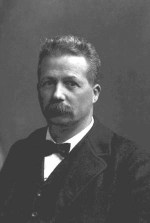the john muir exhibit - people - c. hart merriam
C. Hart Merriam
1855-1942

- U.S. biologist,
chief of the U.S. Biological Survey for 25 years.
- Merriam first
described many genera and species of North American mammals and
plants. From 1910 through 1939, he was a research associate of
the Smithsonian Institution under the E.H. Harriman trust fund.
His studies laid the foundation for the Life Zones concept of biogeographical
elevation gradients. Â He published several books
and some 400 scientific papers.
- Especially after 1910, he became very interested in the linguistics
and mythology of Native Americans. As the North American Indian populations decreased dramatically in the late 19th century, Merriam realized that the people, languages, culture, and knowledge of these diverse tribes was being lost. He became determined to collect information about the Native American tribes of California before it was too late. Merriam largely abandoned his long career in mammalogy for anthropological and linguistic field work, shifting to studying and assisting the Native American tribes in the western US. His contributions on the myths of central California and on ethnogeography were noteworthy. Merriam is credited for collecting in his field notes a vast amount of information on the languages and customs of tribes that would otherwise have been unstudied.
- His appreciation and respect for Native Americans included a desire for better treatment of them. He wrote, "That our treatment of Indians is a stain on civilization everyone knows. Let us even at this late date try to make some amends. Let us cease speaking of an Indian as belonging to a "Digger" tribe, for there is no tribe of that name; and let us cease calling their women squaws, an obnoxious term.... let us drop our air of superiority and treat them as fellow human beings; and let us try to learn from them, before it is too late, the thousand-and-one things worth while for us to know. It may be overtaxing the truth to say that we have as much to learn from them as they from us, but nevertheless, and entirely apart from their superior knowledge of the food, textile, and medicinal values of animals and plants, they can put us to shame in matters of patience, fairness, honor, and kindness." Source: Ethnographic Notes on California Indian Tribes by C.Hart Merriam, Compiled and Edited by Robert F. Heizer, University of California Archaeological Research Facility, Department of Anthropology, Berkeley (October 1966) (PDF - off-site link)
- Muir met Merriam
on the Harriman Alaska Expedition (1899), and they became life-long
friends and correspondents.
Home
| Alphabetical Index
| What's New & About this Site